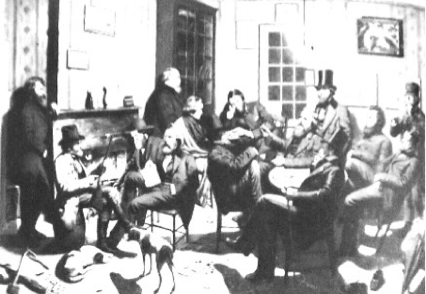Cleveland’s Ark

“An Evening at the Ark”
This 1856 painting shows a group of early leaders of Cleveland, Ohio, who met every week for discussions of natural history. They met at the home of Leonard Case, who for many years was an agent of the Connecticut Land Company. This group of intellectuals included such names as Alfred Kelley, Charles Whittlesey, Harvey Rice, Dr. J. Land Cassels, and Dr. Jared P. Kirtland. Kelley was the civic genius, Rice the great educator, Dr. Cassels the leading physician and chemist, and Dr. Kirtland an outstanding medical doctor and one of the great naturalists of the 19th century. Originally known as Arkites, the group later changed its name to “The Kirtland Society of Natural Sciences.”
In 1835 Leonard Case turned over his one story frame house and office on the northeast corner of Public Square to the Arkites for their collections of birds and mammals and geologic specimens. They named the Case homestead, for obvious reasons, “The Ark.” It remained a thriving organization until age overtook its close-knit membership and dissolved the society through natural attrition of the years. The Ark itself was torn down to make way for the present Cleveland post office.
Leonard Case, Jr., left the Ark and its collection to the City of Cleveland. His will specified that the property was to be sold and the monies were to be used to establish an institution of higher learning to be called Case
School of Applied Sciences. After his death in 1880 the new school was built on some open meadows off Euclid Avenue beyond East 107th Street.
In 1881, Amasa Stone, a prominent Cleveland millionaire, offered $500,000 to Western Reserve College in Hudson, Ohio, if that old institution would transfer to Cleveland and occupy a selected site which happened to be adjacent to that chosen by Case School of Applied Science. The old, but impoverished, Hudson institution accepted Stone’s offer and moved to the Cleveland site in 1882. This was the beginning of Western Reserve University.
In 1967 the two great universities merged under the name of Case Western Reserve University. Included with the University buildings are other cultural institutions, which together encompass an area called University Circle. Here we find the Western Reserve Historical Society, the Cleveland Museum of Art, the Museum of Natural History and Severance Hall.
The geologist and historian Col. Charles Whittlesey was an early member of the Arkites. He was the author of the first authoritative history of Cleveland. Through his prompting in 1867, the Western Reserve Historical Society was organized as a branch of the Cleveland Library. In 1938 the Society moved to its present location on East Boulevard where a wing was added to accommodate the Frederick C. Crawford Auto Aviation Museum. One may conclude that it was from those weekly discussions on nature at “The Ark” and from the membership of “The Kirtland Society of Natural Science” that Cleveland’s largest cultural center grew.
